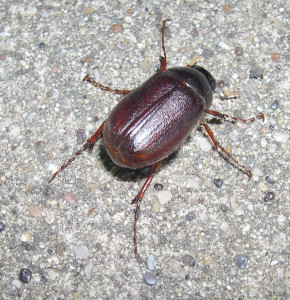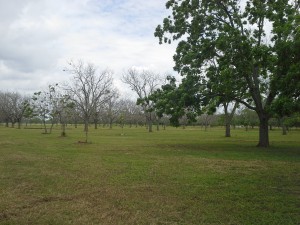
An early April-emerging species of scarab beetle. These early emerging beetles often fool people into thinking they are being invaded by the grass-destroying June beetle.
Nearly everyone who’s grown up in a rural or semi-rural area of Texas knows about “Junebugs”, or more correctly, June beetles. These are the heavy bodied, spindly legged beetles that flock to lights at night. Even in my suburban home, miles from pastures or farm fields, we get June beetles and their relatives coming in waves throughout the spring, clumsily bumping against window screens, drawn by the light.
It seems that “June beetle” is not a very accurate descriptor of the dozens of species of spring emerging scarab beetles that we see every year. Some species emerge long before June, as early as March. And unlike the June beetle, which can be a pest of turfgrass during late summer and fall, these early beetles do not seem to cause much damage to lawn or garden or farm… with a few exceptions.

Pecan orchard in Wharton, TX. Note the younger trees have been almost completely stripped by May beetles. Photo by Bill Ree.
Some of these early species, especially those that emerge during May when trees are leafing out, do cause significant damage to tree foliage. Over 15 species of Phyllophaga (the June beetle genus) have been recorded feeding on pecan alone. According to Bill Ree, Texas A&M AgriLife Extension pecan program specialist, these early emerging beetles can strip the new vegetation from pecan trees.
The tricky thing about diagnosing the cause of damage by May beetles is that they are active only at night. During the day you won’t see any sign of the beetles. To tell if defoliation is caused by May beetles, Ree recommends looking for these things:

Presumed beetle damage to pecan. Note the notched petiole indicated by the arrow. This is a sign of beetle damage. Photo by Bill Ree.
- there is damage but the culprit is nowhere to be found
- damage may be severe, but small patches of foliage may remain in the canopy
- damage is more severe on young trees although larger trees can have some of the same symptoms
- damage goes above any grazing height for deer or livestock, and
- there may be feeding damage on the new stem or petiole where it looks like the adult beetle took a few bites (as indicated by the arrow in the picture)
Whether to treat trees is not an easy question to answer. This sort of damage is unpredictable, and according to Ree it’s not a good idea to treat trees with “hard” (broad spectrum) insecticides early in the season, because of possible negative effects on beneficial insects that control later season pests, like pecan nut casebearer. And, he points out that in most cases, the trees should re-leaf and recover quickly. Nevertheless, if treatment is judged to be needed, beetles can be killed with standard broad-spectrum insecticides labeled for use on pecan, such as chlorpyrifos or one of the pyrethroid insecticides.
For landowners with just a few pecan trees, and no access to commercial spray equipment, treatment should hardly ever be justified. Defoliated trees may need a little extra fertilizer and zinc, according to standard recommendations for pecan production. For more information about pecan growing for homeowners, see http://agrilifelearn.tamu.edu/Guide-to-Pests-of-Peaches-Plums-and-Pecans-p/e-145.htm
